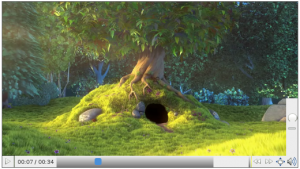As part of my work at Igalia I had to work with video and GStreamer for some years. I always used Gtk+ for that so when I needed to do things with Qt and QML, things were different. In my projects I always used pure GStreamer code instead of the Qt bindings for GStreamer because at the moment those bindings were not ready or reliable.
I know two ways of painting video:
- Overlay way, with a window id and so on
- Texture streaming
I might write later about texture streaming, but I will focus now on overlay.
Painting
The first way means that you need from your graphical toolkit a window id. That window id is asked by the video sink element in a very special moment and you need to provide it in that moment if you have not provided it before. For example, if you are using playbin2 and you already know the sink you want to use, just instantiate your sink and set the window id at that moment with gst_x_overlay_set_window_handle and set the sink to the playbin2 element by setting the video-sink property.
If you are not using playbin2 and for example you are using GStreamer Editing Services, you cannot use a property because currently there is no one and need to use a more complicated method. I already reported the bug with its patches and hope that they apply them as soon as possible to improve compatibility with playbin2 because the way it is now is a bit inconsistent with the rest of GStreamer code base.
Both Qt and Gtk have now client side windows, which means that your program window has only one X window and it is the toolkit that decides which widget is receiving the events. The main consequence is that if we just set the window id, GStreamer will use the whole window and will paint the video over the rest of our widgets (it does not matter if QML/Qt or Gtk+) and you’ll get very ugly effects. To solve that, you need to set the render rectangle, which are the coordinates (relative to the X whole X window) where you want to paint your video. You need to do that just after setting the window id with gst_x_overlay_set_render_rectangle.
If you do not set your window handle and your render rectangle before the pipeline begins to move, it will ask you about that with the prepare-xwindow-id GstMessage, but this message can happen inside the GStreamer threads and it cannot wait until the main loop runs, it needs the information at that very moment, so you need to connect to the synchronous bus handle. GStreamer has a good example at the GstXOverlay documentation about how to do that. To use the callback in C++, you need to declare a static method and pass this as user data parameter, then you can behave almost as having a normal object method. This is the most common solution used in the GNOME world and fits perfectly with the Qt framework too.
The code to get the window id and render rectangle in Gtk+ would be something like:
GdkWindow *gdk_window;
gdk_window = gtk_widget_get_window(your_widget);
/* as sink you can use GST_MESSAGE_SRC() if you are waiting
for the prepare-xwindow-id message */
gst_x_overlay_set_xwindow_id(GST_X_OVERLAY(your_sink),
GDK_WINDOW_XID(gdk_window));
/* do your maths about your coordinates */
gst_x_overlay_set_window_handle(GST_X_OVERLAY(sink),
x, y, width, height);
In Qt, if you are using common widgets, you could use something like:
WId winId = QApplication::activeWindow()->effectiveWinId();
gst_x_overlay_set_xwindow_id(GST_X_OVERLAY(your_sink),
winId);
/* do your maths about your coordinates */
gst_x_overlay_set_window_handle(GST_X_OVERLAY(sink),
x, y, width, height);
If you are using a QGraphicsScene you would do something like:
/* to get the view you could do something like this
(if you have only one or will to mess things up):
QGraphicsView *view = your_scene.views[0];
*/
gst_x_overlay_set_xwindow_id(GST_X_OVERLAY(your_sink),
view->viewport()->effectiveWinId());
/* do your maths about your coordinates */
gst_x_overlay_set_window_handle(GST_X_OVERLAY(sink),
x, y, width, height);
If you are using QML, you would have a very similar approach to the last snippet, because as you should have a QDeclarativeItem, it has a scene() that you can use, to have something like QGraphicsView *view = scene().views[0]; (of course, assuming that you have only one view, which is the most common case).
Overlaying stuff
Some times it is nice do put your controls on top of the video by covering part of the image. It would be like having the video as the background of a canvas where you draw some other widgets. Some GStreamer elements give you the possibility of doing a trick to do this, which is using a colorkey for your background and painting whatever you want on top of that as long as it does not include that colorkey. Some elements like xvimagesink or omapxvsink (used in the Nokia N9 and N950) have the colorkey property that you can read and set. If you are not planning to overlay anything, you can forget about this, but if you do, you need set a color key to the sink and use that color to paint the background of your widget and a good moment is also when setting the window handle:
g_object_set(sink, "autopaint-colorkey", FALSE,
"colorkey", 0x080810, NULL);
Why do I unset the colorkey autopainting? Because I do not want GStreamer to mess my widget painting.
And more important: Why did I use 0x080810? Because it is a dark color, close to black, but it is not black. Pure black can be dangerous as it is commonly used in themes when painting widgets so you would be getting ugly artifacts. Some people recommend magenta (0xFF00FF) as it is supposedly a color that does not exist in nature (citation needed). I would not do it for several reasons:
- You will need to synchronize your painting very well to avoid seeing the colorkey
- If you respect aspect ratio you will see it for sure, because you (or the sink if it is automatic) paint the backgound and the sink draws the image by leaving some empty space.
- It does not behave well with blendings, as you blend from your widget color to the background, which is the colorkey
Advice: do not mess with colorkey and omapxvsink. Though it is supposed to be writable, it is not and it always uses 0x080810.
Aspect ratio
There are two kind of people:
- The ones that want to use all the pixels of their monitor/TVs and like damaging their brain with distorted images.
- The ones that like to see a correctly dimensioned image with some bars giving you a better impression of what was recorded.
As you can guess I belong to the second group.
There are some sinks that do that automatically for you by setting the force-aspect-ratio property, like ximagesink and xvimagesink but there are other that does not and omapxvsink is an example. It is not a big problem but forces you to work a bit more when you select the render rectangle. For that you need to know the video size, which you cannot know until the pipeline is running, which forces to to hook to the GST_MESSAGE_ASYNC_DONE, or in the case of playbin2, you already have the video size when getting the prepare-xwindow-id message. An example to get the video size would be:
GstPad *pad;
GstCaps *caps;
GstStructure *structure;
int width, height;
pad = GST_BASE_SINK_PAD(sink);
caps = GST_PAD_CAPS(pad);
g_return_if_fail(caps && gst_caps_is_fixed(caps));
structure = gst_caps_get_structure(caps, 0);
gst_structure_get_int(structure, "width", &width);
gst_structure_get_int(structure, "height", &height);
/* some videos define a pixel aspect ratio, meaning that the
video pixel could be like 2x1 copared to a squared pixed
and we need to correct this */
if (gst_structure_has_field(structure, "pixel-aspect-ratio")) {
int par_n, par_d;
gst_structure_get_fraction(structure, "pixel-aspect-ratio",
&par_n, &par_d);
width = width * par_n / par_d;
}
/* trick: some sinks perform better with multiple of 2 */
width &= ~1;
height &= ~1;







